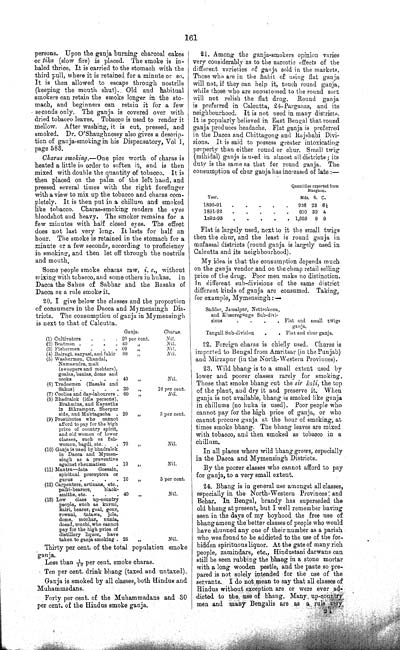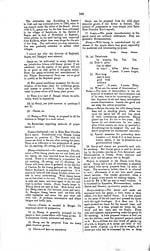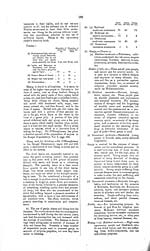Medicine - Drugs > Report of the Indian Hemp Drugs Commission, 1894-1895 > Volume IV
(175) Volume 4, Page 161
Thumbnail gallery: Grid view | List view

161
persons. Upon the ganja
burning charcoal cakes
or tika (slow fire) is placed. The smoke is in-
haled thrice. It is carried to the stomach with the
third pull, where it is retained for a minute or so.
It is then allowed to escape through nostrils
(keeping the mouth shut). Old and habitual
smokers can retain the smoke longer in the sto-
mach, and beginners can retain it for a few
seconds only. The ganja is covered over with
dried tobacco leaves. Tobacco is used to render it
mellow. After washing, it is cut, pressed, and
smoked. Dr. O'Shaughnessy also gives a descrip-
tion of ganja-smoking in his Dispensatory, Vol 1,
page 583.
Charas
smoking.—One pice worth of charas is
heated a little in order to soften it, and is then
mixed with double the quantity of tobacco. It is
then placed on the palm of the left hand, and
pressed several times with the right forefinger
with a view to mix up the tobacco and charas com-
pletely. It is then put in a chillum and smoked
like tobacco. Charas-smoking renders the eyes
bloodshot and heavy. The smoker remains for a
few minutes with half closed eyes. The effect
does not last very long. It lasts for half an
hour. The smoke is retained in the stomach for a
minute or a few seconds, according to proficiency
in smoking, and then let off through the nostrils
and mouth.
Some people smoke charas
raw, i. e., without
mixing with tobacco, and some others in hukas. In
Dacca the Sahus of Sabhar and the Basaks of
Dacca as a rule smoke it.
20. I give below the
classes and the proportion
of consumers in the Dacca and Mymensingh Dis-
tricts. The consumption of ganja in Mymensingh
is next to that of Calcutta.
|
Ganja. |
Charas. |
|
|
(1) Cultivators |
20 per cent. |
Nil. |
|
(2) Boatmen |
40 " |
Nil. |
|
(3) Fishermen |
60 " |
Nil. |
|
(4) Bairagi, sanyasi, and fakir |
80 " |
Nil. |
|
(5) Washermen,
Chandal, |
40 " |
Nil. |
|
(6) Tradesmen (Basaks
and |
30 " |
10 per cent. |
|
(7) Coolies and day-labourers |
60 " |
Nil. |
|
(8) Bhadralok (idle
persons), |
20 " |
5 per cent. |
|
(9) Prostitutes who
cannot |
70 " |
Nil. |
|
(10) Ganja is used by
bhadralok |
10 " |
Nil. |
|
(11) Mantra—data
Gossain, |
10 " |
5 per cent. |
|
(12) Carpenters,
artizans, etc., |
40 " |
Nil. |
|
(13) Low class
up-country |
25 " |
Nil. |
Thirty per cent. of the
total population smoke
ganja.
Less than 1/10 per cent. smoke charas.
Ten per cent. drink bhang (taxed and untaxed).
Ganja is smoked by all
classes, both Hindus and
Muhammadans.
Forty per cent. of the
Muhammadans and 30
per cent. of the Hindus smoke ganja.
21. Among the
ganja-smokers opinion varies
very considerably as to the narcotic effects of the
different varieties of ganja sold in the markets.
Those who are in the habit of using flat ganja
will not, if they can help it, touch round ganja,
while those who are accustomed to the round sort
will not relish the flat drug. Round ganja
is preferred in Calcutta, 24-Parganas, and its
neighbourhood. It is not used in many districts.
It is popularly believed in East Bengal that round
ganja produces headache. Flat ganja is preferred
in the Dacca and Chittagong and Rajshahi Divi-
sions. It is said to possess greater intoxicating
property than either round or chur. Small twig
(mihidal) ganja is used in almost all districts; its
duty is the same as that for round ganja. The
consumption of chur ganja has increased of late:—
|
Quantities exported from |
|||
|
Naogaon. |
|||
|
Year. |
Mds. |
S. |
C. |
|
1890-91 |
926 |
23 |
61/4 |
|
1891-92 |
600 |
39 |
4 |
|
1892-93 |
1,659 |
9 |
0 |
Flat is largely used,
next to it the small twigs
then the chur, and the least is round ganja in
mufassal districts (round ganja is largely used in
Calcutta and its neighbourhood).
My idea is that the
consumption depends much
on the ganja vendor and on the cheap retail selling
price of the drug. Poor men make no distinction.
In different sub-divisions of the same district
different kinds of ganja are consumed. Taking,
for example, Mymensingh:—
|
Saddar, Jamalpur, Nettrokona, |
|
|
and Kissoregunge
Sub-divi- |
|
|
Flat and small twigs |
|
|
ganja. |
|
|
Tangail Sub-division |
Flat and chur ganja. |
22. Foreign charas
is chiefly used. Charas is
imported to Bengal from Amritsar (in the Punjab)
and Mirzapur (in the North-Western Provinces).
23. Wild bhang is
to a small extent used by
lower and poorer classes rarely for smoking.
Those that smoke bhang cut the sir kali, the top
of the plant, and dry it and preserve it. When
ganja is not available, bhang is smoked like ganja
in chillums (no huka is used). Poor people who
cannot pay for the high price of ganja, or who
cannot procure ganja at the hour of smoking, at
times smoke bhang. The bhang leaves are mixed
with tobacco, and then smoked as tobacco in a
chillum.
In all places where wild
bhang grows, especially
in the Dacca and Mymensingh Districts.
By the poorer classes who
cannot afford to pay
for ganja, to a very small extent.
24. Bhang is in
general use amongst all classes,
especially in the North-Western Provinces and
Behar. In Bengal, brandy has superseded the
old bhang at present, but I well remember
having
seen in the days of my boyhood the free use
of
bhang among the better classes of people who would
have shunned any one of their number as a pariah
who was found to be addicted to the use of the for-
bidden spirituous liquor. At the gate of many rich
people, zamindars, etc., Hindustani darwans can
still be seen rubbing the bhang in a stone mortar
with a long wooden pestle, and the paste so pre-
pared is not solely intended for the use of the
servants. I do not mean to say that all classes of
Hindus without exception are or were ever ad-
dicted to the use of bhang. Many up-country
men and many Bengalis are as a rule very
2 A
Set display mode to: Large image | Zoom image | Transcription
Images and transcriptions on this page, including medium image downloads, may be used under the Creative Commons Attribution 4.0 International Licence unless otherwise stated. ![]()
| India Papers > Medicine - Drugs > Report of the Indian Hemp Drugs Commission, 1894-1895 > Volume IV > (175) Volume 4, Page 161 |
|---|
| Permanent URL | https://digital.nls.uk/74552600 |
|---|---|
| Description | Evidence of Bengal witnesses. |
| Description | Volume 4: Evidence of witnesses from Bengal and Assam. |
|---|---|
| Attribution and copyright: |
|




